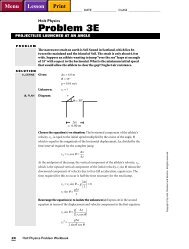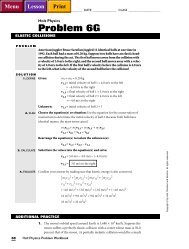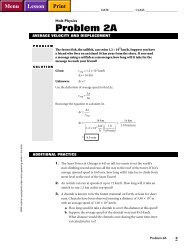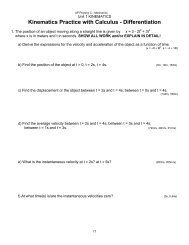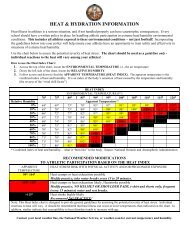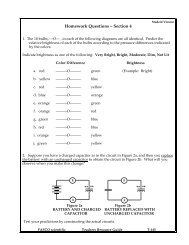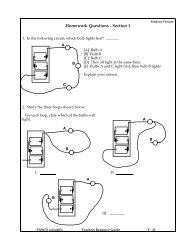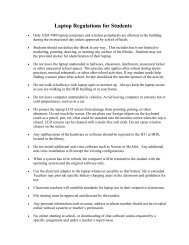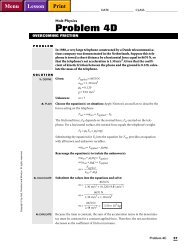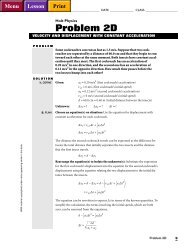Holt Physics Problem 6D - Hays High School
Holt Physics Problem 6D - Hays High School
Holt Physics Problem 6D - Hays High School
You also want an ePaper? Increase the reach of your titles
YUMPU automatically turns print PDFs into web optimized ePapers that Google loves.
NAME ______________________________________ DATE _______________ CLASS ____________________<br />
<strong>Holt</strong> <strong>Physics</strong><br />
<strong>Problem</strong> <strong>6D</strong><br />
CONSERVATION OF MOMENTUM<br />
PROBLEM<br />
SOLUTION<br />
1. DEFINE<br />
2. PLAN<br />
A 20.0 kg cannonball is fired from a 2.40 × 10 3 kg. If the cannon<br />
recoils with a velocity of 3.5 m/s backwards, what is the velocity of the<br />
cannonball?<br />
Given:<br />
m 1 = mass of cannonball = 20.0 kg<br />
m 2 = mass of cannon = 2.40 × 10 3 kg<br />
v 1,i = initial velocity of cannonball = 0 m/s<br />
v 2, i = initial velocity of cannon = 0 m/s<br />
v 2,f = final velocity of cannon = 3.5 m/s backwards =−3.5 m/s<br />
Unknown: v 1, f = final mass of cannonball = ?<br />
Choose the equation(s) or situation: Because the momentum of the cannoncannonball<br />
system is conserved and therefore remains constant, the total initial<br />
momentum of the cannon and cannonball will equal the total final momentum<br />
of the cannon and cannonball.<br />
m 1 v 1,i + m 2 v 2,i = m 1 v 1,f + m 2 v 2,f<br />
Because the cannon and cannonball are initially at rest, the initial momentum for<br />
each is zero. From momentum conservation it follows that the total final momentum<br />
is also zero.<br />
m 1 v 1,f + m 2 v 2,f = 0<br />
Rearrange the equation(s) and isolate the unknown(s):<br />
Copyright © by <strong>Holt</strong>, Rinehart and Winston. All rights reserved.<br />
3. CALCULATE<br />
4. EVALUATE<br />
ADDITIONAL PRACTICE<br />
v 1,f = ⎯ −m 2v ⎯ 2,f<br />
m1<br />
Substitute the values into the equation(s) and solve:<br />
v 1,f =<br />
v 1,f =<br />
−(2.40 × 10 3 kg)(−3.5 m/s)<br />
⎯⎯⎯<br />
20.0 kg<br />
420 m/s forward<br />
=420 m/s<br />
The velocity is positive, indicating the forward direction. The cannonball’s mass<br />
is less than one-hundredth the mass of the cannon, so its speed should be over a<br />
hundred times greater than the recoil speed of the cannon.<br />
1. A student stumbles backward off a dock and lands in a small boat. The<br />
student isn’t hurt, but the boat drifts away from the dock with a<br />
velocity of 0.85 m/s to the west. If the boat and student each have a<br />
mass of 68 kg, what is the student’s initial horizontal velocity?<br />
<strong>Problem</strong> <strong>6D</strong> Ch. 6-7
NAME ______________________________________ DATE _______________ CLASS ____________________<br />
2. A coal barge with a mass of 1.36 × 10 4 kg drifts along a river. When it<br />
passes under a coal hopper, it is loaded with 8.4 × 10 3 kg of coal. What<br />
is the speed of the unloaded barge if the barge after loading has a speed<br />
of 1.3 m/s?<br />
3. A child jumps from a moving sled with a speed of 2.2 m/s and in the<br />
direction opposite the sled’s motion. The sled continues to move in the<br />
forward direction, but with a new speed of 5.5 m/s. If the child has a<br />
mass of 38 kg and the sled has a mass 68 kg, what is the initial velocity<br />
of the sled?<br />
4. A swimmer with a mass of 58 kg and a velocity of 1.6 m/s to the north<br />
climbs onto a 142 kg raft. The combined velocity of the swimmer and<br />
raft is 0.32 m/s to the north. What is the raft’s velocity before the swimmer<br />
reaches it?<br />
5. A 50.0 g shell fired from a 3.00 kg rifle has a speed of 400.0 m/s. With<br />
what speed does the rifle recoil in the opposite direction?<br />
6. Momentum conservation often assumes that the mass of an object remains<br />
constant throughout a process or event. However, a change in<br />
momentum can also occur when mass changes. Consider an automobile<br />
with a full tank of gasoline traveling at a velocity of 88.0 km/h to<br />
the east. The mass of the car when the fuel tank is full is 1292 kg. Suppose<br />
that the car travels along a highway that extends eastward for<br />
600 km. By the time the car has traveled this distance, its mass is<br />
1255 kg. What is the car’s velocity at the end of the journey?<br />
7. In 1976, Comet West was observed to break into four smaller parts as it<br />
orbited near the sun. Suppose a comet with a mass of 5.0 × 10 14 kg and<br />
moving with a speed of 74.0 km/s breaks into two equal parts. One<br />
part moves 15.0° above the original orbit with a speed of 105 km/s,<br />
while a second fragment moves 30.0° below the original orbit. What is<br />
the velocity of the second comet fragment?<br />
8. A twig floating in a small pond is initially at rest. On the twig is a snail,<br />
which begins moving along the length of the twig with a speed of<br />
1.2 cm/s. The twig moves in the opposite direction with a speed of<br />
0.40 cm/s. If the snail’s mass is 2.5 g, what is the mass of twig?<br />
9. A toy that is initially at rest consists of three parts that are held together<br />
by spring-loaded clips. At a given instant, the toy “explodes.” Two of the<br />
pieces, which each have a mass of 25.0 g, travel with velocities of<br />
7.0 cm/s to the south and 7.0 cm/s to the west, respectively. The third<br />
piece has a velocity of 3.3 cm/s at an angle of 45° north of east. What is<br />
the mass of the third piece?<br />
10. An ice skater at rest catches a bag of sand moving to the north with a<br />
speed of 5.4 m/s. This causes both the skater and the bag to move to<br />
the north at a speed of 1.5 m/s. If the skater’s mass is 63 kg, what is the<br />
mass of the bag of sand?<br />
Copyright © by <strong>Holt</strong>, Rinehart and Winston. All rights reserved.<br />
Ch. 6-8<br />
<strong>Holt</strong> <strong>Physics</strong> <strong>Problem</strong> Bank
Additional Practice <strong>6D</strong><br />
Givens<br />
1. m 1 = 68 kg<br />
m 2 = 68 kg<br />
v 2, i = 0 m/s<br />
v 1, f = 0.85 m/s to the west<br />
=−0.85 m/s<br />
v 2, f = 0.85 m/s to the west<br />
=−0.85 m/s<br />
Solutions<br />
m 1 v 1, i + m 2 v 2, i = m 1 v 1, f + m 2 v 2, f<br />
m<br />
v 1, i = 1 v 1, f + m 2 v 2, f − m 2 v<br />
⎯⎯⎯ 2, i<br />
=<br />
mi<br />
v 1, i =−0.85 m/s + (−0.85 m/s) =−1.7 m/s<br />
v 1, i = 1.7 m/s to the west<br />
(68 kg)(−0.85 m/s) + (68 kg)(−0.85 m/s) − (68 kg)(0 m/s)<br />
⎯⎯⎯⎯⎯⎯<br />
68 kg<br />
2. m i = 1.36 × 10 4 kg<br />
m 2 = 8.4 × 10 3 kg<br />
v 2, i = 0 m/s<br />
v 1, f = v 2, f = 1.3 m/s<br />
m 1 v 1, i + m 2 v 2, i = m 1 v 1, f + m 2 v 2, f<br />
v 1, i =<br />
v 1, i =<br />
m 1 v 1, f + m 2 v 2, f − m 2 v 2, i<br />
⎯⎯⎯<br />
m1<br />
(1.36 × 10 4 kg)(1.3 m/s) + (8.4 × 10 3 kg)(1.3 m/s) − (8.4 × 10 3 kg)(0 m/s)<br />
⎯⎯⎯⎯⎯⎯⎯⎯<br />
1.36 × 10 4 kg<br />
1.8 × 10 4 kg•m/s + 1.1 × 10 4 kg•m/s<br />
v 1, i = ⎯⎯⎯⎯ =<br />
1.36 × 10 4 kg<br />
2.9 × 10 4 kg•m/s<br />
⎯⎯<br />
1.36 × 10 4 kg<br />
v 1, i = 2.1 m/s<br />
3. v 1, f = 2.2 m/s backwards<br />
= −2.2 m/s<br />
v 2, f = 5.5 m/s forward<br />
=+5.5 m/s<br />
m 1 = 38 kg<br />
m 2 = 68 kg<br />
m 1 v 1, i + m 2 v 2, i = m 1 v 1, f + m 2 v 2, f<br />
v 1, i = v 2, i , so<br />
v 1, i = ⎯ m 1v1,<br />
f + m2v 2, f (38 kg)(−2.2 m/s) + (68 kg)(5.5 m/s)<br />
⎯ = ⎯⎯⎯⎯<br />
m1<br />
+ m2<br />
38 kg + 68 kg<br />
−84 kg•m/s + 370 kg•m/s 290 kg•m/s<br />
v 1, i = ⎯⎯⎯ = ⎯⎯ = 2.7 m/s<br />
106 kg 106 kg<br />
v 1, i = 2.7 m/s forward<br />
V<br />
4. m 1 = 38 kg<br />
v 1, i = 1.6 m/s to the north<br />
m 2 = 142 kg<br />
v 1, f = 0.32 m/s to the north<br />
v 2, f = 0.32 m/s to the north<br />
5. m 1 = 50.0 g<br />
v 1, i = 0 m/s<br />
v 1, f = 400.0 m/s forward<br />
m 2 = 3.00 kg<br />
v 2, i = 0 m/s<br />
m 1 v 1, i + m 2 v 2, i = m 1 v 1, f + m 2 v 2, f<br />
v 2, i =<br />
v 2, i =<br />
m 1 v 1, f + m 2 v 2, f − m 1 v 1, i<br />
⎯⎯⎯<br />
m2<br />
(38 kg)(0.32 m/s) + (142 kg)(0.32 m/s) − (38 kg)(1.6 m/s)<br />
⎯⎯⎯⎯⎯⎯<br />
142 kg<br />
12 kg•m/s + 45 kg•m/s − 61 kg•m/s −4.0 kg•m/s<br />
v 2, i = ⎯⎯⎯⎯ = ⎯⎯ =−2.8 × 10 −2 m/s<br />
142 kg<br />
142 kg<br />
v 2, i = 2.8 × 10 −2 m/s to the south<br />
Because the initial velocities for both rifle and projectile are zero, the momentum conservation<br />
equation takes the following form:<br />
m 1 v 1, f + m 2 v 2, f = 0<br />
−m −(50.0 × 10 −3 1 v kg)(400.0 m/s)<br />
v 2, f = ⎯ 1, f<br />
= ⎯⎯⎯ = −6.67 m/s<br />
m2<br />
3.00 kg<br />
v 2, f = 6.67 m/s backward<br />
Copyright © by <strong>Holt</strong>, Rinehart and Winston. All rights reserved.<br />
V Ch. 6–6<br />
<strong>Holt</strong> <strong>Physics</strong> Solution Manual
Givens<br />
6. m i = 1292 kg<br />
v i = 88.0 km/h to the east<br />
m f = 1255 kg<br />
Solutions<br />
m i v i = m f v f<br />
v f = ⎯ m ivi<br />
(1292 kg)(88.0 km/h)<br />
⎯ = ⎯⎯⎯<br />
mf<br />
1255 kg<br />
v f = 90.6 km/h to the east<br />
7. m = 5.0 × 10 14 kg<br />
v i = 74.0 km forward<br />
m i = m 2 = ⎯ 1 2 ⎯ m<br />
v 1, f = 105 km/s at 15.0°<br />
above forward<br />
v 2, f is at an angle of −30.0°<br />
to the forward direction<br />
mv i = m 1 v 1, f + m 2 v 2, f<br />
To solve for velocity in two dimensions, the momentum conservation equation must<br />
be written as two equations, one for both the x and y directions.<br />
In the x-direction:<br />
mv i = m 1 v 1, f (cos q 1 ) + m 2 v 2, f (cos q 2 )<br />
v i = ⎯ 1 2 ⎯ v 1, f (cos q 1 ) + ⎯ 1 2 ⎯ v 2, f (cos q 2 )<br />
v 2, f =<br />
v 2, f =<br />
2v i − v 1, f (cos q 1 )<br />
⎯⎯<br />
cos q2<br />
(2)(74.0 km/s) − (105 km/s)(cos 15.0°)<br />
⎯⎯⎯⎯<br />
cos(−30.0°)<br />
148 km/s − 101 km/s<br />
v 2, f = ⎯⎯⎯ =<br />
cos(−30.0°)<br />
v 2, f = 54 km/s<br />
In the y-direction (check):<br />
0 = m 1 v 1, f (sin q 1 ) + m 2 v 2, f (sin q 2 )<br />
v 1, f (sin q 1 ) =−v 2, f (sin q 2 )<br />
47 km/s<br />
⎯⎯<br />
cos(−30.0°)<br />
(105 km/s)(sin 15.0°) =−(54 km/s)[sin(−30.0°)]27.2 km/s = 27 km/s<br />
The slight difference arises from differences in the number of significant figures and<br />
from rounding.<br />
v 2,f = 54 km/s at 30.0° below the initial forward direction<br />
Copyright © by <strong>Holt</strong>, Rinehart and Winston. All rights reserved.<br />
8. v 1, i = 0 cm/s<br />
v 1, f = 1.2 cm/s forward<br />
=+1.2 cm/s<br />
v 2, i = 0 cm/s<br />
v 2, f = 0.40 cm/s backward<br />
=−0.40 cm/s<br />
m 1 = 2.5 g<br />
m 1 v 1, f + m 2 v 2, f = 0<br />
−m<br />
m 2 = 1 v −(2.5 g)(1.2 cm/s)<br />
⎯ 1, f<br />
= ⎯⎯<br />
v2, f −0.40 cm/s<br />
m 2 = 7.5 g<br />
V<br />
Section Five—<strong>Problem</strong> Bank V Ch. 6–7
Givens<br />
9. v i = 0 cm/s<br />
m 1 = 25.0 g<br />
m 2 = 25.0 g<br />
v 1 = 7.0 cm/s to the south<br />
= 7.0 cm/s at −90° from<br />
east<br />
v 2 = 7.0 cm/s to the west<br />
= 7.0 cm/s at 180° from<br />
east<br />
v 3 = 3.3 m/s at 45° north of<br />
east<br />
Solutions<br />
m 1 v 1, f + m 2 v 2, f + m 3 v 3, f = 0<br />
In the x-direction:<br />
m 1 v 1, f (cos q 1 ) + m 2 v 2, f (cos q 2 ) + m 3 v 3, f (cos q 3 ) = 0<br />
m 3 =<br />
m 3 =<br />
m 1 v 1, f (cos q 1 ) + m 2 v 2, f (cos q 2 )<br />
⎯⎯⎯⎯<br />
−v 3, f (cos q 3 )<br />
− (25.0 g)(7.0 cm/s)(cos −90°) + (25.0 g)(7.0 cm/s)(cos 180°)<br />
⎯⎯⎯⎯⎯⎯⎯<br />
−(3.3 cm/s)(cos 45°)<br />
(25.0 g)(7.0 cm/s)<br />
m 3 = ⎯⎯ =<br />
(3.3 cm/s)(cos 45°)<br />
In the y-direction (check):<br />
75 g<br />
m 1 v 1, f (sin q 1 ) + m 2 v 2, f (sin q 2 ) + m 3 v 3, f (sin q 3 ) = 0<br />
(25.0 g)(7.0 cm/s)[sin(−90°)] + (25.0 g)(7.0 cm/s)(sin 180°)<br />
+ (75 g)(3.3 cm/s)(sin 45°) = 0<br />
−180 g•cm/s + 0 g•cm/s + 180•g•cm/s = 0<br />
10. v 1, i = 0 m/s<br />
v 2, i = 5.4 m/s to the north<br />
v 1, f = 1.5 m/s to the north<br />
v 2, f = 1.5 m/s to the north<br />
m 1 = 63 kg<br />
m 1 v 1, i + m 2 v 2, i = m 1 v 1, f + m 2 v 2, f<br />
m 1 v 1, f − m 1 v (63 kg)(1.5 m/s) − (63 kg)(0 m/s)<br />
m 2 = ⎯⎯ 1, i<br />
= ⎯⎯⎯⎯ =<br />
v2, i − v 2, f<br />
5.4 m/s − 1.5 m/s<br />
m 2 = 24 kg<br />
(63 kg)(1.5 m/s)<br />
⎯⎯<br />
3.9 m/s<br />
Additional Practice 6E<br />
1. m 1 = 1550 kg<br />
m 2 = 770 kg<br />
v 2, i = 0 m/s<br />
v f = 9.44 m/s forward<br />
2. m 1 = 0.17 kg<br />
m 2 = 0.75 kg<br />
v 2, i = 0.50 m/s to the left<br />
=−0.50 m/s<br />
v f = 4.2 m/s to the right<br />
=+4.2 m/s<br />
v 1, i =<br />
(m 1 + m 2 )v f − m 2 v 2, i<br />
⎯⎯⎯<br />
m1<br />
(1550 kg + 770 kg)(9.44 m/s) − (770 kg)(0 m/s)<br />
v 1, i = ⎯⎯⎯⎯⎯ =<br />
1550 kg<br />
v 1, i = 14.0 m/s forward<br />
v 1, i =<br />
v 1, i =<br />
v 1, i =<br />
(m 1 + m 2 )v f − m 2 v 2, i<br />
⎯⎯⎯<br />
m1<br />
(0.17 kg + 0.75 kg)(4.2 m/s) − (0.75 kg)(−0.50 m/s)<br />
⎯⎯⎯⎯⎯⎯<br />
0.17 kg<br />
(0.92 kg)(4.2 m/s) + 0.38 kg•m/s<br />
⎯⎯⎯⎯<br />
0.17 kg<br />
3.9 kg•m/s + 0.38 kg•m/s<br />
v 1, i = ⎯⎯⎯ =<br />
0.17 kg<br />
v 1, i = 25 m/s to the right<br />
4.3 kg•m/s<br />
⎯⎯ 0.17 kg<br />
(2320 kg)(9.44 m/s)<br />
⎯⎯<br />
1550 kg<br />
Copyright © by <strong>Holt</strong>, Rinehart and Winston. All rights reserved.<br />
V<br />
V Ch. 6–8<br />
<strong>Holt</strong> <strong>Physics</strong> Solution Manual




